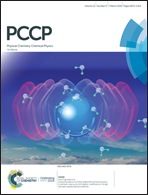A conformation-specific IR spectroscopic signature for weak C![[double bond, length as m-dash]](https://www.rsc.org/images/entities/char_e001.gif) O⋯C
O⋯C![[double bond, length as m-dash]](https://www.rsc.org/images/entities/char_e001.gif) O n→π* interaction in capped 4R-hydroxyproline†
O n→π* interaction in capped 4R-hydroxyproline†
Abstract
Collagen, the most abundant protein in animals, has a unique triple helical structure comprising three parallel left-handed polyproline II (PPII) strands while each of the strands consists of a repeating sequence of X–Y–Gly, where X = proline (Pro) and Y = 4-hydroxyproline (Hyp). Collagen forms a stable triple helix of very long polypeptide strands despite the absence of intra-strand hydrogen bonding in the individual polypeptide chains. It has been reported that non-covalent n→π* interaction plays a significant role in stabilizing the individual polypeptide strands in collagen. However, there is no direct spectroscopic evidence for the presence of this interaction in collagen or its building block. Herein, we have observed for the first time a conformation-specific IR spectroscopic signature for C![[double bond, length as m-dash]](https://www.rsc.org/images/entities/char_e001.gif) O⋯C
O⋯C![[double bond, length as m-dash]](https://www.rsc.org/images/entities/char_e001.gif) O n→π*-amide interaction in a capped Hyp residue, the most important monomer building block of collagen, using isolated gas phase IR spectroscopy and quantum chemistry calculations. The proof of the existence of this interaction in a model monomer has implications for better understanding of its role not only in structures of collagen but also most of the other proteins and larger peptides.
O n→π*-amide interaction in a capped Hyp residue, the most important monomer building block of collagen, using isolated gas phase IR spectroscopy and quantum chemistry calculations. The proof of the existence of this interaction in a model monomer has implications for better understanding of its role not only in structures of collagen but also most of the other proteins and larger peptides.
![Graphical abstract: A conformation-specific IR spectroscopic signature for weak C [[double bond, length as m-dash]] O⋯C [[double bond, length as m-dash]] O n→π* interaction in capped 4R-hydroxyproline](/en/Image/Get?imageInfo.ImageType=GA&imageInfo.ImageIdentifier.ManuscriptID=C8CP07660J&imageInfo.ImageIdentifier.Year=2019)
- This article is part of the themed collections: 2019 PCCP HOT Articles and 1st International Conference on Noncovalent Interactions


 Please wait while we load your content...
Please wait while we load your content...
![[double bond, length as m-dash]](https://www.rsc.org/images/entities/h2_char_e001.gif) O⋯C
O⋯C